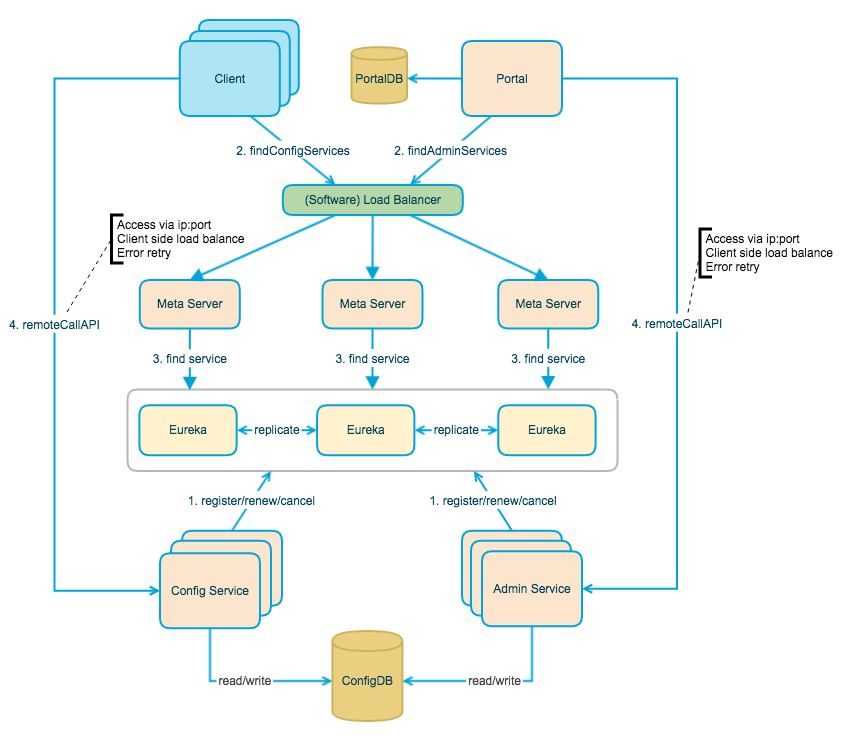java 中间件介绍: Apollo
Apollo 简介 Apollo中的几个核心概念:
application (应用)
这个很好理解,就是实际使用配置的应用,Apollo客户端在运行时需要知道当前应用是谁,从而可以去获取对应的配置
每个应用都需要有唯一的身份标识 – appId,我们认为应用身份是跟着代码走的,所以需要在代码中配置,具体信息请参见Java客户端使用指南 。
environment (环境)
配置对应的环境,Apollo客户端在运行时需要知道当前应用处于哪个环境,从而可以去获取应用的配置
我们认为环境和代码无关,同一份代码部署在不同的环境就应该能够获取到不同环境的配置
所以环境默认是通过读取机器上的配置(server.properties中的env属性)指定的,不过为了开发方便,我们也支持运行时通过System Property等指定,具体信息请参见Java客户端使用指南 。
cluster (集群)
一个应用下不同实例的分组,比如典型的可以按照数据中心分,把上海机房的应用实例分为一个集群,把北京机房的应用实例分为另一个集群。
对不同的cluster,同一个配置可以有不一样的值,如zookeeper地址。
集群默认是通过读取机器上的配置(server.properties中的idc属性)指定的,不过也支持运行时通过System Property指定,具体信息请参见Java客户端使用指南 。
namespace (命名空间)
一个应用下不同配置的分组,可以简单地把namespace类比为文件,不同类型的配置存放在不同的文件中,如数据库配置文件,RPC配置文件,应用自身的配置文件等
应用可以直接读取到公共组件的配置namespace,如DAL,RPC等
应用也可以通过继承公共组件的配置namespace来对公共组件的配置做调整,如DAL的初始数据库连接数
上图简要描述了Apollo的总体设计,我们可以从下往上看:
Config Service提供配置的读取、推送等功能,服务对象是Apollo客户端
Admin Service提供配置的修改、发布等功能,服务对象是Apollo Portal(管理界面)
Config Service和Admin Service都是多实例、无状态部署,所以需要将自己注册到Eureka中并保持心跳
在Eureka之上我们架了一层Meta Server用于封装Eureka的服务发现接口
Client通过域名访问Meta Server获取Config
Service服务列表(IP+Port),而后直接通过IP+Port访问服务,同时在Client侧会做load balance、错误重试
Portal通过域名访问Meta Server获取Admin
Service服务列表(IP+Port),而后直接通过IP+Port访问服务,同时在Portal侧会做load balance、错误重试
为了简化部署,我们实际上会把Config Service、Eureka和Meta Server三个逻辑角色部署在同一个JVM进程中
基础 如何工作? @EnableApolloConfig引出ApolloConfigRegistrar注册类
因为继承了ImportBeanDefinitionRegistrar
从而调用了registerBeanDefinitions
从而注册了PropertySourcesProcessor
由PropertySourcesProcessor引出ConfigServiceConfigService引出ConfigManager并且是guice框架DefaultInjectorDefaultInjector找出相关的guice框架的关联类guice找到ConfigManager—->DefaultConfigManager
在DefaultConfigManager又可以看到getConfig方法主要来找配置ConfigFactoryManager去寻找工厂并通过工厂创建相关的configDefaultConfigFactory去create相关的配置
RemoteConfigRepository,主要获取本地的appid和cluster以及dataCenterRemoteConfigRepository线程池定时刷新远程一旦previous!=current就获取RepositoryChangeListener的观察者LocalFileConfigRepository实现了RepositoryChangeListener所以会做更新本地缓存
相关配置 1 2 开发环境名和集群名 /opt/settings/server.properties
源码相关-客户端 客户端模块-结构图
客户端-流程时序图
ApolloConfigRegistrar @EnableApolloConfig引出ApolloConfigRegistrar注册类ImportBeanDefinitionRegistrarregisterBeanDefinitionsPropertySourcesProcessor
1 在AbstractApplicationContext#invokeBeanFactoryPostProcessors里的过程
ConfigService 由PropertySourcesProcessor引出ConfigService
AbstractApplicationContext#invokeBeanFactoryPostProcessors方法体系中
1 2 3 4 5 6 7 8 9 10 11 12 13 14 15 16 17 18 19 20 21 22 PropertySourcesProcessor#postProcessBeanFactory PropertySourcesProcessor#initializePropertySources protected void initializePropertySources () .... ImmutableSortedSet<Integer> orders = ImmutableSortedSet.copyOf(NAMESPACE_NAMES.keySet()); Iterator<Integer> iterator = orders.iterator(); while (iterator.hasNext()) { int order = iterator.next(); for (String namespace : NAMESPACE_NAMES.get(order)) { Config config = ConfigService.getConfig(namespace); composite.addPropertySource(new ConfigPropertySource(namespace, config)); } } environment.getPropertySources().addFirst(composite); }
ConfigManager 由ConfigService引出ConfigManager并且是guice框架
1 2 3 4 5 6 7 8 9 10 11 12 13 14 15 16 ConfigService#getConfig public static Config getConfig (String namespace) return s_instance.getManager().getConfig(namespace); } private ConfigManager getManager () if (m_configManager == null ) { synchronized (this ) { if (m_configManager == null ) { m_configManager = ApolloInjector.getInstance(ConfigManager.class); } } } return m_configManager; }
首先Spi找出DefaultInjector,然后利用DefaultInjector找出相关的guice框架的关联类
1 2 3 4 5 6 7 8 9 10 11 12 13 14 15 16 17 18 19 20 21 22 23 24 25 ServiceBootstrap.loadFirst(Injector.class); public DefaultInjector () try { m_injector = Guice.createInjector(new ApolloModule()); } catch (Throwable ex) { ApolloConfigException exception = new ApolloConfigException("Unable to initialize Guice Injector!" , ex); Tracer.logError(exception); throw exception; } } private static class ApolloModule extends AbstractModule @Override protected void configure () bind(ConfigManager.class).to(DefaultConfigManager.class).in(Singleton.class); bind(ConfigFactoryManager.class).to(DefaultConfigFactoryManager.class).in(Singleton.class); bind(ConfigRegistry.class).to(DefaultConfigRegistry.class).in(Singleton.class); bind(ConfigFactory.class).to(DefaultConfigFactory.class).in(Singleton.class); bind(ConfigUtil.class).in(Singleton.class); bind(HttpUtil.class).in(Singleton.class); bind(ConfigServiceLocator.class).in(Singleton.class); bind(RemoteConfigLongPollService.class).in(Singleton.class); } }
看完guice的绑定就知道如何利用guice找到ConfigManager—->DefaultConfigManager
ConfigFactoryManager&&DefaultConfigFactory 在DefaultConfigManager又可以看到getConfig方法主要来找配置,如果不存在则利用ConfigFactoryManager去寻找工厂并通过工厂创建相关的config
1 2 3 4 5 6 7 8 9 10 11 12 13 14 15 16 17 18 19 20 21 22 23 24 25 @Override public Config getConfig (String namespace) Config config = m_configs.get(namespace); if (config == null ) { synchronized (this ) { config = m_configs.get(namespace); if (config == null ) { ConfigFactory factory = m_factoryManager.getFactory(namespace); config = factory.create(namespace); m_configs.put(namespace, config); } } } return config; } public DefaultConfigManager () m_factoryManager = ApolloInjector.getInstance(ConfigFactoryManager.class); }
从ConfigFactoryManager找到了相关的DefaultConfigFactory
然后通过DefaultConfigFactory去create相关的配置,先看本地如果本地没有则加载网络上的
1 2 3 4 5 6 7 8 9 10 11 12 13 14 15 16 17 18 19 @Override public Config create (String namespace) DefaultConfig defaultConfig = new DefaultConfig(namespace, createLocalConfigRepository(namespace)); return defaultConfig; } LocalFileConfigRepository createLocalConfigRepository (String namespace) { if (m_configUtil.isInLocalMode()) { logger.warn("==== Apollo is in local mode! Won't pull configs from remote server for namespace {} ! ====" ,namespace); return new LocalFileConfigRepository(namespace); } return new LocalFileConfigRepository(namespace, createRemoteConfigRepository(namespace)); } RemoteConfigRepository createRemoteConfigRepository (String namespace) { return new RemoteConfigRepository(namespace); }
RemoteConfigRepository
主要获取本地的appid和cluster以及dataCenter,然后带有重试机制的去拿服务器的相关配置
这个类主要加载远程apollo服务器上的配置文件的
1 2 3 4 5 6 7 8 9 10 11 12 13 14 15 16 17 18 19 20 21 22 23 24 25 26 27 28 29 30 31 32 33 34 35 36 37 38 39 40 41 42 43 44 45 46 47 48 49 50 51 52 53 private ApolloConfig loadApolloConfig () ..... String appId = m_configUtil.getAppId(); String cluster = m_configUtil.getCluster(); String dataCenter = m_configUtil.getDataCenter(); ...... List<ServiceDTO> configServices = getConfigServices(); String url = null ; for (int i = 0 ; i < maxRetries; i++) { ..... for (ServiceDTO configService : randomConfigServices) { url = assembleQueryConfigUrl(configService.getHomepageUrl(), appId, cluster, m_namespace, dataCenter, m_remoteMessages.get(), m_configCache.get()); HttpRequest request = new HttpRequest(url); Transaction transaction = Tracer.newTransaction("Apollo.ConfigService" , "queryConfig" ); transaction.addData("Url" , url); try { HttpResponse<ApolloConfig> response = m_httpUtil.doGet(request, ApolloConfig.class); ... ApolloConfig result = response.getBody(); return result; } catch (ApolloConfigStatusCodeException ex) { ..... } catch (Throwable ex) { ...... } finally { transaction.complete(); } onErrorSleepTime = m_configNeedForceRefresh.get() ? m_configUtil.getOnErrorRetryInterval() : m_loadConfigFailSchedulePolicy.fail(); } } String message = String.format( "Load Apollo Config failed - appId: %s, cluster: %s, namespace: %s, url: %s" , appId, cluster, m_namespace, url); throw new ApolloConfigException(message, exception); }
RemoteConfigLongPollService
后期主要以此Service进行长轮训为主
由RemoteConfigRepository构造函数中含有的scheduleLongPollingRefresh
1 2 3 private void scheduleLongPollingRefresh () remoteConfigLongPollService.submit(m_namespace, this ); }
开启了远程配置长轮训服务
1 2 3 4 5 6 7 8 9 10 11 12 13 14 15 16 17 18 19 20 21 22 23 24 25 26 27 28 29 30 31 32 33 34 35 36 37 38 39 40 41 42 43 public boolean submit (String namespace, RemoteConfigRepository remoteConfigRepository) boolean added = m_longPollNamespaces.put(namespace, remoteConfigRepository); m_notifications.putIfAbsent(namespace, INIT_NOTIFICATION_ID); if (!m_longPollStarted.get()) { startLongPolling(); } return added; } ...... private void startLongPolling () if (!m_longPollStarted.compareAndSet(false , true )) { return ; } try { final String appId = m_configUtil.getAppId(); final String cluster = m_configUtil.getCluster(); final String dataCenter = m_configUtil.getDataCenter(); final long longPollingInitialDelayInMills = m_configUtil.getLongPollingInitialDelayInMills(); m_longPollingService.submit(new Runnable() { @Override public void run () if (longPollingInitialDelayInMills > 0 ) { try { logger.debug("Long polling will start in {} ms." , longPollingInitialDelayInMills); TimeUnit.MILLISECONDS.sleep(longPollingInitialDelayInMills); } catch (InterruptedException e) { } } doLongPollingRefresh(appId, cluster, dataCenter); } }); } catch (Throwable ex) { m_longPollStarted.set(false ); ApolloConfigException exception = new ApolloConfigException("Schedule long polling refresh failed" , ex); Tracer.logError(exception); logger.warn(ExceptionUtil.getDetailMessage(exception)); } }
长轮训一旦接收到notification变更通知,则将监听器通知变更,RemoteConfigRepository得到通知进行变更,然后通知LocalFileConfigRepository去变更,再通知到DefaultConfig去变更相关数据



国内查看评论需要代理~